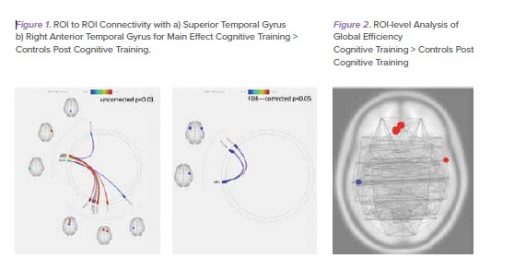Analysis of Resting State Functional Connectivity in a Cognitive Training Intervention Study
Abstract: As part of a larger randomized controlled study by Hill, Zewelanji, and Faison (2015), 30
of the 225 participating high school students were randomly assigned to one of three conditions:
ThinkRx, BrainSkills, or study hall (control). In addition to pre and post cognitive testing these
students underwent pre and post MRI imaging. Functional MRI was used to assess changes in
resting state functional connectivity associated with cognitive training, and correlation of changes in
functional connectivity to cognitive testing findings. Analysis of cognitive testing scores found that
the cognitive training groups scored significantly higher than controls on multiple tasks, with the most
significant gain occurring in auditory processing: auditory analysis segmenting (F=16.3, p=0.000)
and auditory analysis drop (F=13.6, p=0.001). Analysis of resting state connectivity with the auditory
cortex (superior temporal gyrus and right anterior temporal gyrus) revealed significant changes in
the resting state connectivity with multiple cortical regions involved in cognitive processing (Figure
1). In addition, an increase in global network efficiency (network T=2.44, p-unc 0.02; PaCiG l : T=4.56,
p-FDR=.01; MedFC: T=4.14, p-FDR=0.02; pITG l: T=-3.05, p-FDR=0.23; aSTG r: T=2.86, p-FDR=0.27)
was found to occur following cognitive training (Figure 2). Further, analysis revealed that network
changes correlated to auditory processing gains.

Reference: Ledbetter, C., Faison, M., Hill, O., & Patterson, J. (2016). Analysis of Resting State Functional Connectivity in a Cognitive Training Intervention Study. Poster presented at Center for Brain Health Annual Symposium: Reprogramming the Brain to Health: Computational Psychiatry and Neurology, University of Texas at Dallas, April 14, 2016.
The full results can be found in LearningRx’s 48-page 2016 edition of “Client Outcomes and Research Results.” http://www.learningrx.com/our-programs/learningrx-results/.






